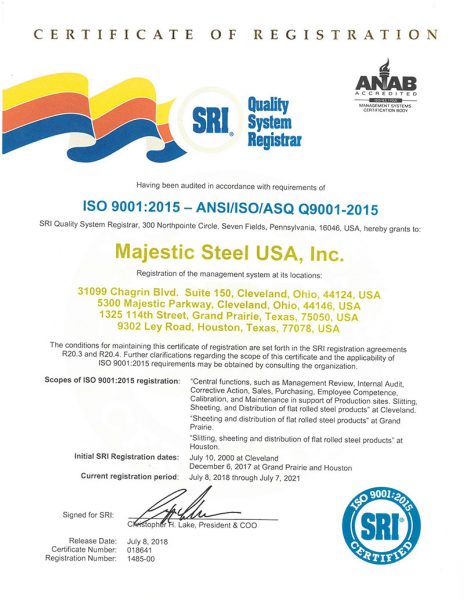Market Update | January 19th 2022
CONSTRUCTION DEMAND GROWING AS MANUFACTURING SLOWS
Demand from the manufacturing sector has started to plateau after climbing for the last eighteen months. Longer lead times and an increase in unfilled orders are contributing to the leveling within the manufacturing sector. Construction, specifically within the housing market, continues to grow. Confidence of U.S. homebuilders is rising, housing starts are at the highest rate since March, and permits continue to climb.
INPUT COSTS
Zinc pricing remained firm this week after a sharp increase to start the New Year.
– Zinc pricing remained above $1.60/lb this week; holding at that level since the week before Christmas.
– However, longer-term forecasts expect pricing to return to the recent $1.40/lb.-$1.45/lb. average.
Spot iron ore pricing was virtually flat this week, holding at $127.30/dmt.
– While spot iron ore pricing is down 1.0% w/w, pricing is still up 3.3% m/m.
Pacific basin met coal pricing continued to climb this week, hitting a fresh all-time high.
– Met coal pricing climbed to $420/mt, up 9.1% from last week.
– Pricing is also up 23.0% m/m and up 237% y/y.
Oil pricing continued to push higher this week, climbing to a 7-year high of $86.00/barrel.
– An attack in the UAE raised concerns about a supply squeeze, coupled with limited disruption from the recent Omicron surge, helped to push pricing higher.
– Goldman Sachs predicted this week that we will see $100/barrel oil in 2022.
SUPPLY
After sliding during the holiday season, domestic raw steel production rebounded for the second consecutive week last week.
– U.S. steelmakers produced 1.833 million tons at an 83.2% utilization rate.
– This is the highest weekly production (tons) since mid-November.
– Year-to-date production is 5.0% above the total from the same period last year.
Based on preliminary import license data, the daily average of imports (17 days), for January, is down 12.4% compared to the pace through the same timeframe in December.
– Excluding Brazilian slabs, the daily average in January is down 15.3% from December.
The startup of the new SDI EAF in Sinton, TX has been delayed once again.
– The startup of the melt shop at the 3.0 million ton/yr. mill is being pushed back to February from the recent goal of December.
DEMAND
Growth in business activity from the manufacturing sector, leveled off in New York after climbing for the previous eighteen months.
– The January Empire Manufacturing Index came in at -0.7, down sharply from 31.9 in December.
– The two-month average dipped to 15.6, its lowest level since March.
– Any reading above 0.0 indicates growth, while readings below 0.0 denote contraction.
While shipments remained virtually flat, new orders declined slightly.
– Lengthening delivery lead times and a growing amount of unfilled orders also helped to level off growth.
Confidence among U.S. homebuilders remained very strong in January.
– The Housing Market Index came in at 83, virtually flat from the 84 reading in December and the 83 reading from January 2021.
– Any reading over 50.0 indicates an increase in optimism, while any reading below 50.0 denotes a contraction in outlook.
– All three components remained strong in January, with the present situation remaining the strongest at 90.0.
– The next six months and traffic components showed solid growth once again by coming in at 83.0 and 69.0, respectively.
New housing starts came in at a 1.702 million-unit rate in December, up 1.4% from November and up 2.5% from December 2020.
– This is the third consecutive monthly increase and starts are at their highest rate since March.
– The boost in starts in December came from multi-family units, which increased 10.6% from November.
– Permits, an indicator of future construction, increased as well, climbing a sharp 9.1% from November to a 1.873 million unit rate in December.
– For 2021, actual new housing starts totaled 1.595 million units, up 15.6% compared to 2020 and is at the highest annual total since 2006.
This material, information and analyses (the “Content”) may include certain statements, estimates and projections prepared with respect to, among other things, historical data and anticipated performance. Content may reflect various assumptions by Majestic Steel USA, Inc. concerning anticipated results that are inherently subject to significant economic, competitive and other uncertainties and contingencies and have been included for illustrative purposes. Content is provided AS-IS.

